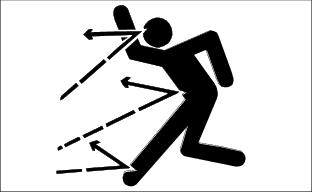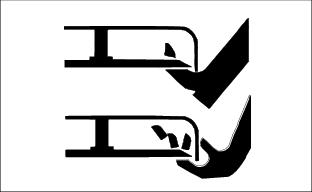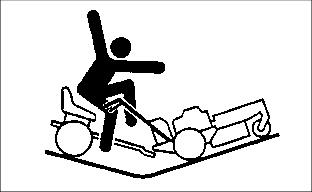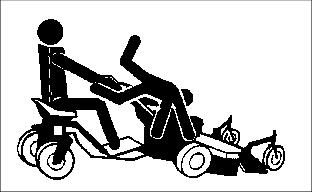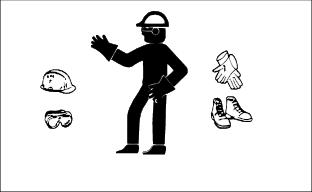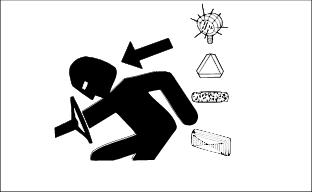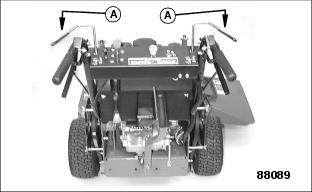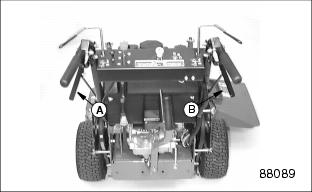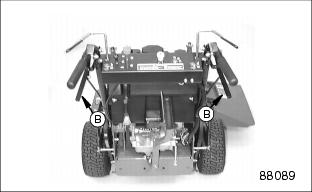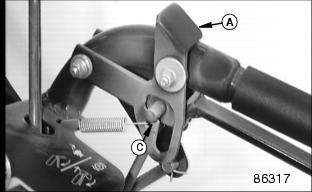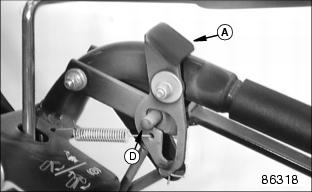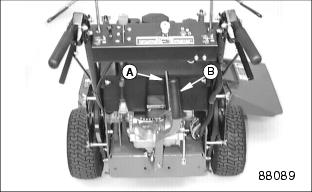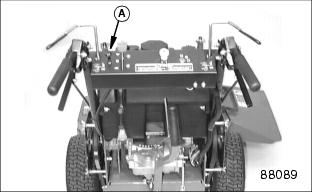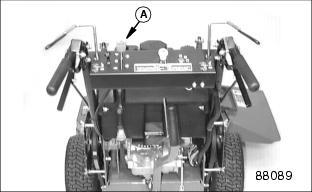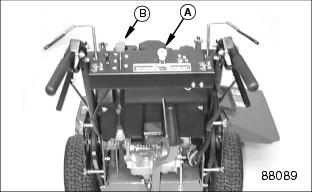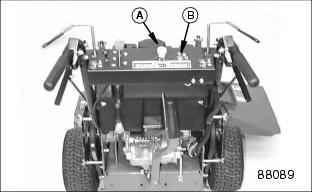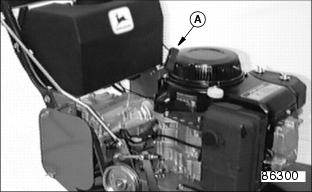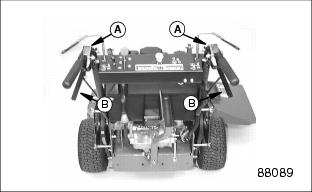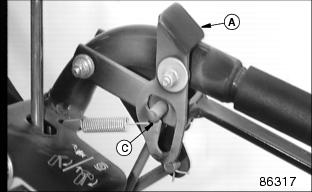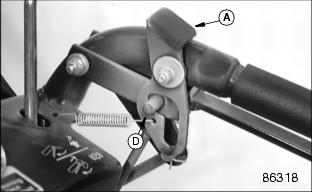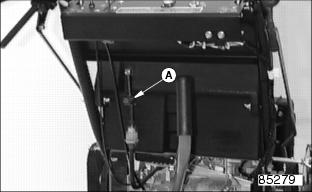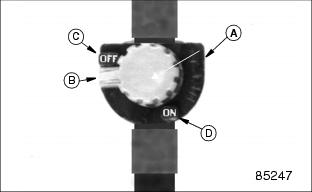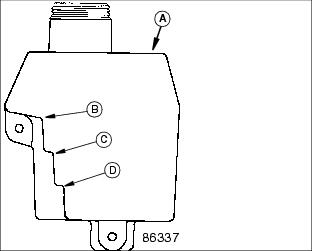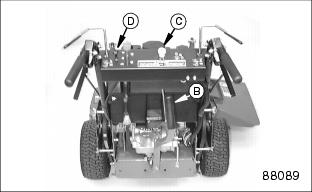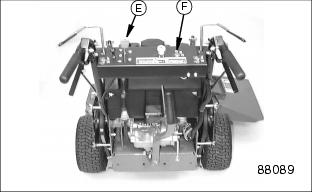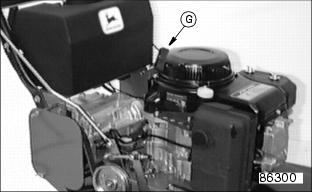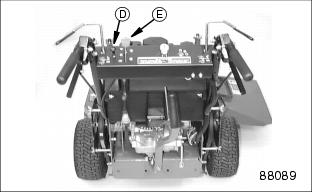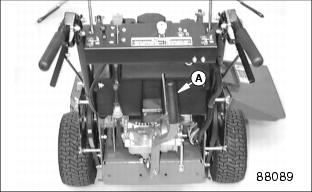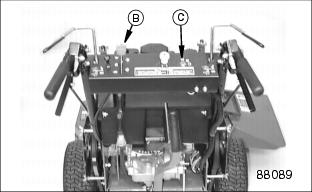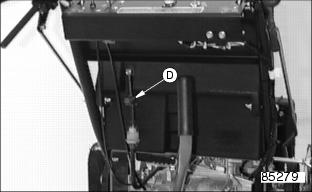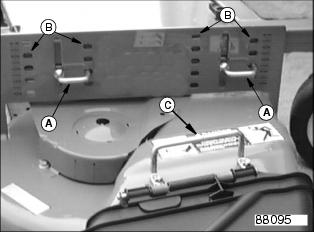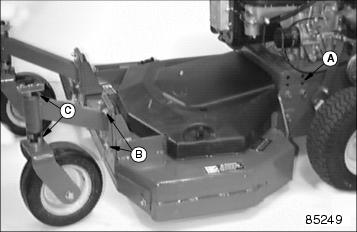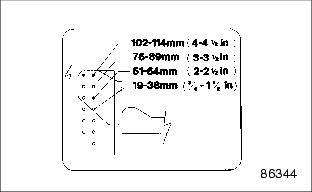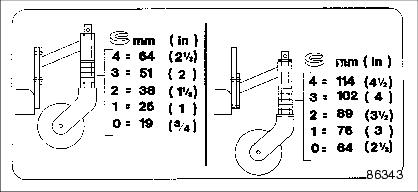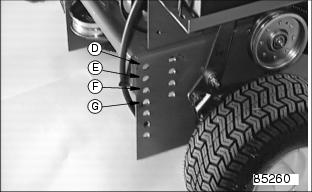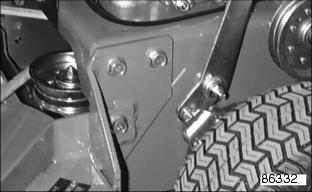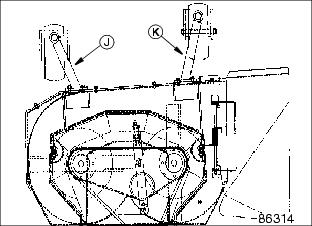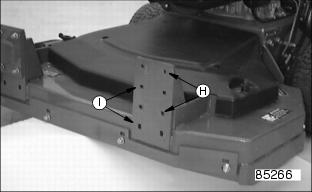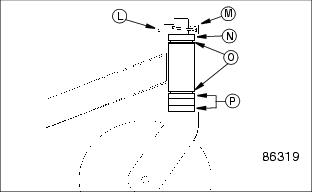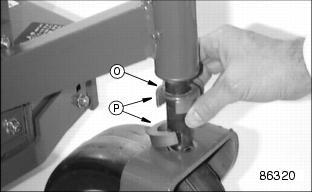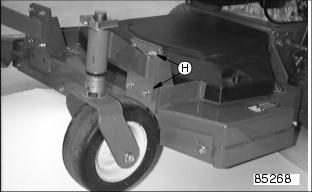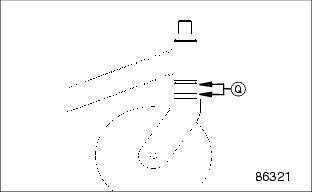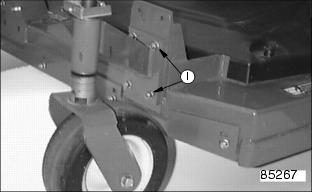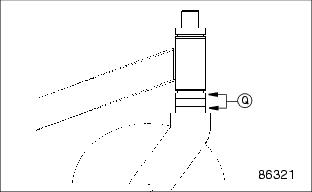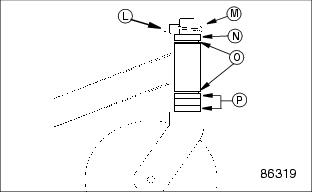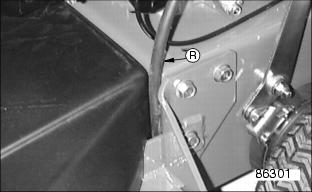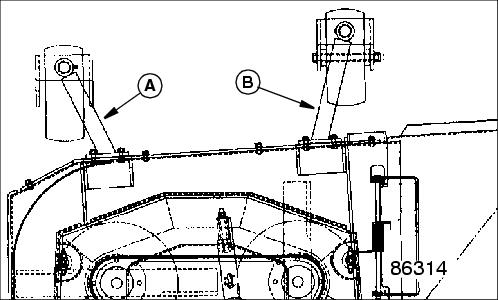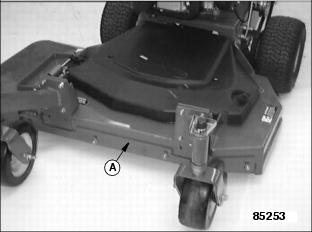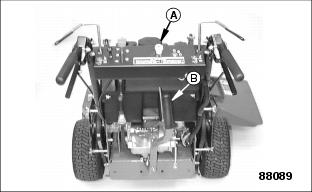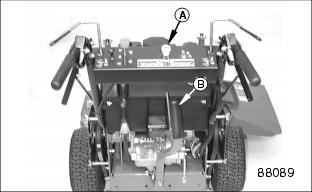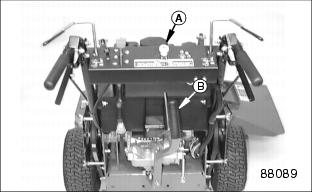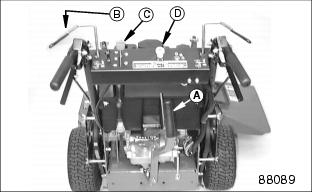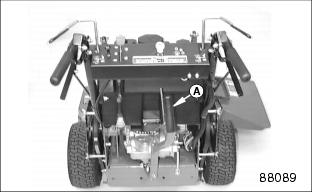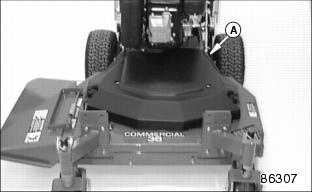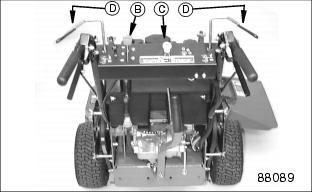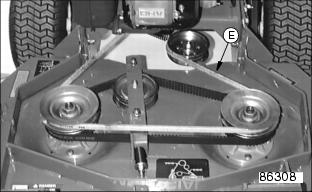Introduction
Safety Signs
Controls
Operating
Rotating Blades Are Dangerous - Protect Children And Prevent Accidents
Using Starter Handle (Recoil Start)
Adjusting Mower Deck Height (48/54-Inch Decks)
Adjusting Mower Deck Height (36-Inch Decks)
Change Mower Deck Height (36-Inch Decks)
Optional Left Hand Caster Position (36-Inch Decks)
Adjusting Mower Deck Front Bracket (36-Inch Decks)
Avoid Damage To Plastic And Painted Surfaces
Checking Mower Blade Stop Time
Replacement Parts
Service Machine Safely
Service Interval Chart
Service Engine
Service Engine
Service Transmission
Service Steering & Brakes
Service Mower
Service Electrical
Service Miscellaneous
Troubleshooting
Storing Machine
Assembly
Specifications
Warranty
Service Literature
CopyrightŠ Deere & Company

Operating
Operate Safely
ˇ Check brake action before you operate. Adjust or service brakes as necessary.
ˇ Inspect machine before you operate. Be sure hardware is tight. Repair or replace damaged, badly worn, or missing parts. Be sure guards and shields are in good condition and fastened in place. Make any necessary adjustments before you operate.
ˇ Clear work area of objects that might be thrown. Keep people and pets out of the work area. Stop machine if anyone enters the area.
ˇ If you hit an object, stop the machine and inspect it. Make repairs before you operate. Keep machine and attachments properly maintained and in good working order.
ˇ DO NOT leave machine unattended when it is running.
ˇ Only operate during daylight or with good artificial light.
ˇ Be careful of traffic when operating near or crossing roadways.
ˇ Do not wear radio or music headphones while operating the machine. Safe operation requires your full attention.
Park Safely
ˇ Stop machine on a level surface, not on a slope.
ˇ Before you leave the operator's station, wait for engine and all moving parts to STOP.
Rotating Blades Are Dangerous - Protect Children And Prevent Accidents
ˇ Never assume that children will remain where you last saw them. Children are attracted to mowing activity, stay alert to the presence of children.
ˇ Keep children in the house when you are operating the machine.
ˇ Turn machine off if a child enters the mowing area.
ˇ Use extra care when you come to blind corners, shrubs, trees, or other objects that may block your vision.
ˇ DO NOT let children or an untrained person operate the machine.
ˇ DO NOT carry or let children ride on machine or any attachment. DO NOT tow children in a cart or trailer.
HELP PREVENT SERIOUS OR FATAL ACCIDENTS:
ˇ Be alert at all times, drive forward carefully. People ESPECIALLY CHILDREN can move quickly into the mowing area before you know it.
ˇ Back carefully. Shut off PTO and look behind the machine carefully, ESPECIALLY FOR CHILDREN, before you back up.
ˇ DO NOT mow in reverse unless it is absolutely necessary.
ˇ Shut off PTO when you are not mowing.
ˇ DO NOT operate machine if you are under the influence of drugs or alcohol.
Operate Sulky Safely
ˇ Use sulky ONLY on EVEN terrain for mowing mostly in a straight line.
ˇ Be careful when you drive sulky and mower through a dip. Handlebars may hit you, ESPECIALLY when you make a turn.
Avoid Tipping
ˇ DO NOT drive where machine could slip or tip.
ˇ Stay alert for holes and other hidden hazards in the terrain.
ˇ Slow down before you make a sharp turn or operate on a slope.
ˇ Drive across a hill-not up and down. Be careful when you change direction on a slope.
ˇ DO NOT stop when going up hill or down hill. If machine stops going up hill, STOP PTO and back down slowly.
ˇ DO NOT mow wet grass. Reduced traction could cause sliding.
Operator Training Required
ˇ Study operation section of this manual before operating the machine.
ˇ Operate machine in an open, unobstructed area under the direction of an experienced operator.
ˇ Learn the use of all controls.
ˇ Operator experience is required to learn the moving, stopping, turning and other operating characteristics of the machine.
Keep Riders Off
ˇ Only allow the operator on the sulky. Keep riders off sulky and mower.
ˇ Riders on the machine may be struck by foreign objects or thrown off the machine causing serious injury.
ˇ Riders obstruct the operator's view resulting in the machine being operated in an unsafe manner.
Wear Appropriate Clothing
ˇ Wear close fitting clothing and safety equipment appropriate for the job.
ˇ Loud noise can cause impairment or loss of hearing, wear a suitable protective device such as earplugs.
Transport Safely
ˇ Use safety lights and devices. Slow moving machines when driven on public roads are hard to see, especially at night. Avoid personal injury or death resulting from a collision with a vehicle.
ˇ Whenever driving on public roads, use flashing warning lights and turn signals according to local regulations. Extra flashing warning lights may need to be installed.
Using Operator Presence
The operator presence system is designed to protect the operator. The operator presence lever (A) can be operated by either the left or right hand.
To operate the PTO, the operator presence lever (A) must be held down against the handlebars by the operator.
If the operator releases the operator presence lever (A) while mowing; the engine will automatically stop.
Using Hand Brake Levers
The hand brake levers (A & B) are used to steer the unit. When a hand brake lever is engaged or partially engaged, the drive wheel is disconnected from the transmission and the steering brake is applied. The left and right hand sides work independently from each other.
Left brake lever (A) controls left drive wheel. Pull and hold lever against handle to turn LEFT.
Right brake lever (B) controls right wheel. Pull and hold lever against handle to turn RIGHT.
If brake levers are not adjusted equally or unit does not steer correctly, see Adjusting Brakes or Adjusting Drive Wheel Belt Tension in the Service - Steering and Brakes section or Adjusting Tire Pressure in the Service - Miscellaneous section.
Emergency Stopping:
ˇ Pull up brake levers to stop forward movement.
ˇ Lock brake levers by pushing brake lever locks forward.
ˇ Release operator presence lever.
ˇ Turn ignition key to the "OFF" position.
Using Brake Lever Locks
The brake lever locks are designed to operate as a parking brake. When the brake levers are locked in the engaged position: the drive wheels are disconnected from the transmission and the left and right steering brakes are engaged. The left and right hand sides work independently from each other.
1. Pull up brake levers (B) to stop forward movement.
2. Push lever locks (A) forward with thumbs:
ˇ Operational Brake detent position (C).
ˇ Park Brake detent position (D).
To release brake lever locks; pull up on brake levers and locks will automatically release.
If brake levers are not adjusted equally or the brake lever locks cannot be engaged, see Adjusting Brakes in the Service - Steering And Brakes section.
Using Speed Selector Lever
Speed Selector Lever (B) controls the units forward speed and reverse motion.
Forward:
ˇ It is OK to shift on-the-go among forward speeds.
ˇ There are five forward speeds available: "1" is the slowest speed and "5" is the fastest speed.
ˇ Speed range is approximately: 2.4 to 9.3 km/h (1.5 to 5.8 mph).
ˇ The transmission shift lever "N" neutral location is adjustable. If necessary, adjust neutral "N" location. see Adjusting Transmission Shift Lever in the Service - Transmission section.
Reverse:
ˇ Stop forward movement before you shift into reverse.
ˇ Pull reverse lock (A) towards speed selector lever (B). Move speed selector lever into reverse "R" position.
ˇ Reverse speed is approximately: 2.9 km/h (1.8 mph).
ˇ The reverse lock (A) should be fully seated in the speed indicator plate neutral "N" notch. If necessary adjust the reverse lock, see Adjusting Transmission Reverse Lock Lever in the Service - Transmission section.
The transmission controls the units forward and reverse motion through out all the gears. If you suspect any slippage in the drivetrain, check the tension on the drive belts:
ˇ See Adjusting Transmission Drive Belt Tension in the Service - Transmission section.
ˇ See Adjusting Drive Wheel Belt Tension in the Service - Steering And Brakes section.
Using Choke
Using Throttle Lever
Push lever all the way forward to FAST ) position. Use this position when you mow.
Pull lever to rear to SLOW ) position. Do not run engine at SLOW idle any longer than necessary.
Using PTO Switch
NOTE: Prior to engaging the PTO, the operator presence lever must be engaged. See Using Operator Presence Lever in this section.
Engage PTO:
ˇ Move throttle lever (B) to the 3/4 FAST ) position.
ˇ Move throttle lever (B) forward to the FAST ) position for mowing.
Disengage PTO:
Using Key Switch
Start Engine:
1. Move shift lever to "N" neutral position.
2. Make sure PTO knob (A) is pushed down (disengaged).
3. Turn key switch (B) to the "position.
ˇ Electric Start Model: Turn key switch to the "R" position to start engine.
Stop Engine:
ˇ Turn key switch to the "STOP" position.
Using Starter Handle (Recoil Start)
1. Pull starter handle (A) slowly until you feel resistance within the engine.
2. Pull starter handle fast and steady. Repeat until engine starts.
3. Let starter handle return slowly. Do not let handle snap back when engine starts.
Setting Parking Brake
When the brake levers (B) and brake levers locks (A) are in the engaged position: the drive wheels are disconnected from the transmission and the left and right steering brakes are engaged. The left and right hand sides work independently from each other.
Set Parking Brake:
ˇ Pull up brake levers (B) to stop forward movement.
ˇ Push lever locks (A) forward with thumbs:
ˇ Operational Brake detent position (C).
ˇ Park Brake detent position (D)
Release Parking Brake:
ˇ To release brake lever locks; pull up on brake levers and locks will automatically release.
If brake levers are not adjusted equally or the brake lever locks cannot be engaged, see Adjusting Brakes in the Service - Steering And Brakes section.
Using Fuel Shut-Off Valve
This unit is equipped with a 2-position fuel shut-off valve (A). Turn "Red" knob (B) clockwise or counterclockwise to open or close the fuel shut-off valve.
CLOSED (OFF) position (C):
ˇ When performing any type of engine service.
OPEN (ON) position (D):
ˇ Fuel shut-off valve must be in the full OPEN (ON) position for proper fuel delivery to the engine.
Using Fuel Gauge
The fuel tank (A) has a built in fuel gauge.
2. Look inside fuel tank. Fuel tank has molded-in steps showing the approximate amount of fuel left in the tank.
Starting Engine
1. Check fuel shut-off valve (A):
ˇ Valve must be in the full OPEN (ON) position. (See Using Fuel Shut-Off Valve in this section).
2. Move shift lever (B) to neutral "N" position.
If the shift lever neutral "N" indicator rod is aligned with the "N" on the indicator label, but the transmission is not in neutral. See Adjusting Shift Lever Neutral or Adjusting Transmission Reverse Lock Rod in the Service - Transmission section.
3. PTO knob (C) must be in OFF (DOWN) position.
ˇ Cold engine: Pull knob up to the CHOKE position.
ˇ Warm/Hot engine: If necessary, pull up knob to CHOKE position.
5. Move throttle lever (E) to set engine speed:
ˇ Cold engine: set throttle lever at 3/4 FAST ) position.
ˇ Warm / Hot engine: set throttle lever in the FAST ) position.
6. Turn key (F) to " position.
ˇ Move choke knob (D) to the OFF position.
ˇ Move throttle lever (E) to the desired engine speed.
Stopping Engine
IMPORTANT: Avoid damage! Do not stop engine when mower is heading down a slope of more than 10°: Oil may run through valve train into carburetor and muffler. |
Follow steps below before you park, inspect or adjust this unit.
1. Put the speed selector lever (A) in neutral "N" position.
2. Slowly move throttle lever (B) back to the SLOW ) position.
3. Turn key (C) to "STOP" position.
4. Move fuel shut-off valve (D) to the CLOSED (OFF) position. (See Using Fuel Shut-Off Valve in this section)
Adjusting Mower Deck Height (48/54-Inch Decks)
The mower deck height adjustment consists of nine different cutting heights. The nine cutting heights range from 25-127 mm (1-5 in.) in 13 mm (1/2 inch) increments. The cutting height indicators (B) are labeled in the mower deck support frame.
NOTE: To maintain a level mower deck, both sides, front and rear of the deck must be adjusted equally.
To change the mower deck cutting height:
ˇ Pull out spring-loaded pins (A).
ˇ Lift or lower mower deck using handle (C) to the desired mower deck height indicator (B).
ˇ Make sure spring-loaded pins are fully engaged into the mower deck support bracket holes.
Adjusting Mower Deck Height (36-Inch Decks)
The mower deck height adjustment consists of nine different cutting heights. The nine cutting heights range from 19-114 mm (3/4-4 1/2 in).
The mower deck height adjustment consists of:
(Please review Mower Deck Labels)
ˇ Four sets of mounting holes in the power
unit frame (A).
ˇ Two sets of mounting holes in the caster
wheel supports (B).
Change Mower Deck Height (36-Inch Decks)
Choose a mower deck cutting height and start by attaching the mower deck to the power unit frame as listed below.
2. Connect mower deck to mounting holes in the power unit frame using six M12 cap screws and M12 locknuts, tighten locknuts to 140 Nˇm (105 lb-ft) see example:
ˇ Use holes (D) for a cutting height of 102-114 mm (4-4 1/2 in).
ˇ Use holes (E) for a cutting height of 76-89 mm
(3-3 1/2 in).
ˇ Use holes (F) for a cutting height of 51-64 mm
(2-2 1/2 in).
ˇ Use holes (G) for a cutting height of 19-38 mm
(3/4-1 1/2 in).
Example: This mower deck cutting height is set at 102-114 mm (4-4 1/2 in).
3. Connect both caster wheel supports (J and K) to mounting holes in the mower deck frame using eight M8 carriage bolts and M8 locknuts. Tighten locknuts to
25 Nˇm (18.5 lb-ft).
Always adjust left and right caster wheel supports equally:
NOTE: Identify left (J) and right (K) caster wheel supports prior to attaching them to the mower deck frame.
ˇ Use top mounting holes (H) for cutting heights of 19-64 mm (3/4-2 1/2 in).
NOTE: When the bottom mounting holes are used. Install the lower carriage bolts with the bolt head to the inside of the mower deck to avoid grass clippings from collecting on the hardware.
ˇ Use bottom mounting holes (I) for cutting heights of 64-114 mm (2 1/2-4 1/2 in).
NOTE: The caster wheel height adjustment can be made without removing the caster wheel from the caster wheel bracket.
4. Adjust caster wheel height. Install spacers according to desired mower deck cutting height:
ˇ Put a 150 mm (6 inch) block under the front edge of the mower deck.
ˇ Remove lynch pin (L) and pin guard (M). When lynch pin is removed the caster wheel will drop to the floor.
ˇ Align the open section of the spacer with the "Flats" on the spindle shaft.
ˇ Remove or add spacers (P) as required for your mower deck height. (For correct spacer placement see the following steps or the label on mower deck).
Always adjust left and right caster wheels equally.
NOTE: The caster wheel brackets must be attached to the mower deck in the upper set of mounting holes (H).
ˇ Decks set at 19 mm (3/4 in), use no (0) spacers at location (Q).
ˇ Decks set at 25 mm (1 in), use one (1) spacer at location (Q).
ˇ Decks set at 38 mm (1 1/2 in), use two (2) spacers at location (Q).
ˇ Decks set at 51mm (2 in), use three (3) spacers at location (Q).
Decks set at 64 mm (2 1/2 in), use four (4) spacers at location (Q).
ˇ Always adjust left and right caster wheels equally.
NOTE: The caster wheel brackets must be attached to the mower deck in the lower set of mounting holes (I).
ˇ Decks set at 64 mm (2 1/2 in), use no (0) spacers at location (Q).
ˇ Decks set at 76 mm (3 in), use one (1) spacer at location (Q).
ˇ Decks set at 89 mm (3 1/2 in), use two (2) spacers at location (Q).
ˇ Decks set at 102 mm (4 in), use three (3) spacers at location (Q).
ˇ Decks set at 114 mm (4 1/2 in), use four (4) spacers at location (Q).
5. Always store extra spacers on caster spindle at location (N).
6. With the correct number of spacers installed, assemble each caster wheel.
7. Remove block from under mower deck.
ˇ When a 36-Inch Mower Deck is attached to a GS45 or GS75 Power Deck equipped with electric start, route the battery vent hose (R) between frame and belt cover.
Optional Left Hand Caster Position
(36-Inch Decks)
If you are experiencing a grass striping problem that is in alignment with the left caster wheel, try this solution:
ˇ Remove left caster wheel support (A).
ˇ Purchase another right caster wheel support (B) from your John Deere dealer.
NOTE: For proper installation, see Adjusting Mower Deck Height in this section.
ˇ Install new right caster wheel support (B) on to the mower deck where you removed the left caster wheel support.
ˇ Transfer the caster wheel assembly from the left support to the new right support.
Adjusting Mower Deck Front Bracket
(36-Inch Decks)
The mower deck front bracket (A) is designed to comply with Domestic (United States) and CE (European) safety standards. This bracket is essentially an extension of the front of the mower deck weldment.
In most cases this bracket should not be changed.
Bracket in lower position:
ˇ This position is for CE (European) safety standards.
Bracket in upper position:
ˇ This position is for Domestic (United States) safety standards. This standard allows the front deck skirt to be higher with respect to the blade height. This position offers improved cutting performance in tall grass. Grass entering the deck is bent over less, prior to blade entry.
Daily Operating Checklist
o Remove grass and debris from machine.
Avoid Damage To Plastic And Painted Surfaces
ˇ Insect repellent spray may damage plastic and painted surfaces. Do not spray insect repellent near machine.
ˇ Be careful not to spill fuel on machine. Fuel may damage surface. Wipe up spilled fuel immediately.
Transporting Machine
Use a heavy-duty trailer to transport your machine.
Drive machine forward onto a trailer.
Leave unit in gear, do not put in neutral "N".
Fasten machine to trailer with heavy-duty straps, chains, or cables. Both front and rear straps must be directed down and outward from machine.
Trailer must have signs and lights required by law.
Testing Safety System
NOTE: This unit is equipped with a Electronic Safety Interlock. Engine will not start unless:
ˇ PTO switch is in the Disengaged position.
ˇ Transmission is in "N" neutral.
Use the following checkout procedure to check for normal operation.
If there is a malfunction during one of these procedures, DO NOT operate machine. (See your John Deere dealer)
Perform these tests in a clear open area.
TEST 1
1. Push PTO switch (A) down to the DISENGAGED position.
2. Put transmission lever (B) in neutral "N".
3. Try to start engine. Engine should start.
NOTE: If engine does not start, there is a problem. (See your John Deere dealer.)
TEST 2
1. Pull PTO switch (A) up to the ENGAGED position.
2. Put transmission lever (B) in neutral "N".
3. Try to start engine. Engine MUST NOT start.
NOTE: If engine does not start, there is a problem. (See your John Deere dealer.)
TEST 3
1. Push PTO switch (A) down to the Disengaged position.
2. Put transmission lever (B) in 1st gear.
3. Try to start engine. Engine MUST NOT start.
NOTE: If engine does not start, there is a problem. (See your John Deere dealer.)
TEST 4
2. Put transmission lever (A) in neutral "N".
3. Start engine and move throttle lever (C) to ONE-HALF speed position.
4. With operator presence lever (B) held down, pull PTO switch (D) up to the ENGAGED position. Mower deck will start up.
5. Release operator presence lever. Engine MUST stop.
NOTE: If engine does not start, there is a problem. (See your John Deere dealer.)
TEST 5
2. Put transmission lever (A) in neutral "N".
3. Push PTO switch (D) down to the disengaged position.
4. Start engine and move throttle lever (C) to ONE-HALF speed position.
5. With operator presence lever (B) held down, shift transmission lever (A) to 1st gear.
6. Release operator presence lever. Engine MUST stop.
NOTE: If engine does not start, there is a problem. (See your John Deere dealer.)
TEST 6
NOTE: This test should be performed on a hard rough surface such as a blacktop parking lot.
2. Put transmission lever (A) in neutral "N".
3. Push and pull machine - rear wheels (drive wheels) should skid.
4. Parking brakes MUST prevent machine from moving.
NOTE: If machine moves (drive wheels turn), the brakes need to be adjusted. (See Adjusting Brakes in the Service - Steering And Brakes section.)
Checking Mower Blade Stop Time
3. Start engine and move throttle lever (B) to the 1/2 to 3/4 FAST ) position.
4. With operator presence levers (D) held down, pull PTO switch (C) up to the ENGAGED position.
Mower deck will start up. Observe the entire mower drive system (E) spinning.
5. Move throttle lever (B) forward to the FAST ) position.
6. Check the mower blade stop time:
ˇ Push PTO switch (C) down to the DISENGAGED position and begin timing.
ˇ Watch mower drive belt. Note time when belt stops to get blade stop time.
ˇ If blade stop time is more than 6 seconds, adjust PTO clutch. See Adjusting PTO Clutch in the Service - Electrical section.

